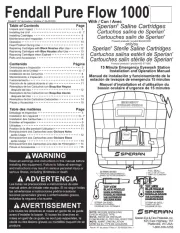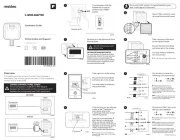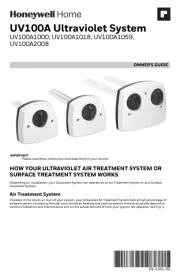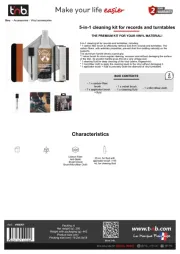Honeywell F300B2012 Handleiding
Honeywell
Niet gecategoriseerd
F300B2012
Bekijk gratis de handleiding van Honeywell F300B2012 (6 pagina’s), behorend tot de categorie Niet gecategoriseerd. Deze gids werd als nuttig beoordeeld door 49 mensen en kreeg gemiddeld 5.0 sterren uit 25 reviews. Heb je een vraag over Honeywell F300B2012 of wil je andere gebruikers van dit product iets vragen? Stel een vraag
Pagina 1/6

OWNER’S GUIDE
69-0756-07
F50F and F300E Electronic
Air Cleaners
CONTENTS
Operating Your Electronic Air Cleaner ....................... 2
Getting the Most From Your Electronic Air Cleaner 2
Cleaning Prefilter(s), Cell(s) and Postfilter(s) ......... 3
How Electronic Air Cleaning Works ............................. 5
Before You Call for Service .............................................. 6
Resideo 10 Year Ultraclean Coil Guarantee™ .......... 6
Limited Five-year Warranty ............................................ 7
Product Registration ......................................................... 8
M38810

F50F AND F300E ELECTRONIC AIR CLEANERS
69-0756—07 2
OPERATING YOUR
ELECTRONIC AIR CLEANER
GETTING THE MOST FROM
YOUR ELECTRONIC AIR
CLEANER
Run the electronic air cleaner as much as
possible
For greatest efficiency, the air cleaner should run all the
time. To do this, set the Fan switch on your thermostat to
On, and make sure the air cleaner is turned on. The fan
and air cleaner run even when the furnace or air
conditioner is off.
NOTE: A manual fan switch may be built into the furnace
or furnace fan controller.
The air cleaner uses less power than a 40 watt light bulb
(two-cell model—33 watts; single cell model—22 watts).
Many believe that the added cost is more than offset by
the added benefits of full-time air cleaning and full-time
air circulation. And you may feel that the room
temperature stays more even when the fan is always on.
Even if your thermostat does not have a Fan On position,
you can obtain maximum available air cleaning benefit by
making sure the air cleaner is always turn to On so it
operates whenever the furnace or air conditioner is on.
Keep the cell(s) and prefilter(s) clean
Although the air cleaner is designed to be efficient over a
wide range of cell dirt loading conditions, regular cleaning
is your best assurance of consistent performance. Also, a
very dirty prefilter and cell reduces air flow and, in turn,
this reduces the efficiency of the furnace or air
conditioner.
Replace postfilter regularly
A high-efficiency postfilter is sometimes installed in the
air cleaner. This filter increases the efficiency of the air
cleaner and should be changed every six months of usage.
If you have a humidifier
All Resideo whole house humidifiers can be used in a
system with the Resideo Electronic Air Cleaner without
any additional filters or system modification.
If your system includes an atomizing humidifier, you may
want to install a standard furnace filter between the
humidifier and the air cleaner.This filter would keep the
humidifier spray mineral deposits from collecting on the
air cleaner.This filter should be checked regularly and
changed when it shows signs of mineral or dirt buildup. If
you do not install a filter, you will probably need to wash
the cell(s) and prefilter(s) more often to remove the
mineral buildup.
If an ultrasonic room humidifier is used often, especially if
filled with tap (undistilled) water, the cell(s) and prefilter(s)
require more frequent washing. A white residue
accumulates on the cell(s) from the minerals in the water.
This residue may also contribute to "white dust.” See About
lint or “white dust” section for more information.
Turn the On-Off switch on the power
box to On.
NOTE: Set the switch to 1 for On
and set the switch to O for
Off.
The air cleaner now operates
whenever your furnace/air
conditioning system fan operates.
For maximum air cleaning benefit
and cleaner air conditioner coils,
leave the air cleaner switch turned
on at all times and the thermostat
fan switch set to On. Of course,
continuous fan operation adds to
your electric bill each month. Check
your equipment for the amount of
electricity needed to run your
System fan.
When the fan and air cleaner come
on, the neon indicator lights.
You may hear a snapping (electrical
arcing) sound occasionally as the air
cleaner operates. This is usually
caused by a larger dust particle that
causes a high voltage discharge.The
snapping sound means that your air
cleaner is working as it should.To
hear the snapping sound,
momentarily press the test button
near the botton of the door. Use the
test button any time you want to
prove air cleaner operation.
The switch remains in the On
position to keep the air cleaner
running.
When the fan and air cleaner stops,
the neon light goes off. The air
cleaner is off until the heating or air
conditioning and fan start again.
If you do not want the air cleaner to
run, set the On-Off switch to Off to
turn off the air cleaner. Your furnace
and air conditioner continue to
operate normally, but without the
added benefit of air cleaning.
Normally, this switch should be turn
to On at all times.
M3584A
M3586A
M6032A
M3585A
M3583A

F50F AND F300E ELECTRONIC AIR CLEANERS
69-0756—07 4
CAUTION
Burn Hazard.
Can cause personal injury.
Allow cell(s) to cool completely in dishwasher and
at tend of wash cycle or wear protective gloves.
Washing the cell(s) in your automatic
dishwasher
Hot water can accumulate in the tubes supporting the
collector plates.Tip the cell(s) so these tubes can drain.
IMPORTANT
• Check your dishwasher Owner’s manual. Some
manufacturers do not recommend washing elec-
tronic cell(s) in their dishwashers.
• If the dishwasher has upper and lower arms, posi-
tion the cell(s) carefully to allow good water circu-
lation.
• Be careful to avoid damaging the cell(s) when
placing them in the dishwasher. Broken ionizer
wires or bent collector plates are not covered
under the Warranty.
• Very dirty cell(s), especially from tobacco or cook-
ing smoke, can discolor the plastic parts and the
lining of some dishwashers.This discoloration is
not harmful. To minimize it, wash the cell(s) more
frequently or try a different brand of detergent.
• Do NOT allow the dishwasher to run through the
dry cycle. This bakes on any contaminants not
removed during the wash cycle and reduces air
cleaner efficiency.
1. Put the cell(s) on the lower rack of the dishwasher
with the airflow arrow pointing up. It may be neces-
sary to remove the upper rack. Do not block water
flow to the upper arm.
HINT: Lay a few large water glasses between the spikes on
the lower rack, and rest the cell(s) on them so the spikes do
not damage the aluminum collector blades.
2. Using your regular dishwashing detergent, allow the
dishwasher to run through the complete wash and
rinse cycle. Do not use the dry cycle. To avoid burns,
let the cell(s) cool completely before removing, or
wear protective gloves when removing the cell(s).
Remember that water may be trapped inside the
cell(s) plates. Tip the cell(s) so these tubes can drain.
3. Wipe the ionizer wires and contact board on the end
of the cell using your thumb and forefinger with a
small, damp cloth.
4. Inspect the dishwasher. You may want to rerun the
wash and/or rinse cycle with the dishwasher empty if
you see dirt or residue from washing the cell(s). If
dirt or residue seems excessive, wash the cell(s)
more often or try a different detergent.
CAUTION
Hazardous Chemical.
Can cause personal injury.
Do not splash detergent solution in eyes.
Washing the cell(s) in a tub
• Wear rubber gloves to avoid prolonged detergent
contact with your skin.
• Keep detergent and solution out of reach
of children.
NOTE: Always wash the cell(s) first, then the prefilter(s),
to keep heavy prefilter lint from getting caught in
the cell(s).
1. Use a large enough container, such as a laundry tub
or trash container, to hold one or both cell(s).
NOTE: Sharp corners on the cell(s) can scratch the sur-
face of a bathtub.
2. Dissolve about three-fourth cup of automatic dish-
washer detergent per cell in enough hot water to
cover the cell(s). If the detergent does not dissolve
readily, or forms a scum on the water, try another
brand, or use softened water.
3. After the detergent has completely dissolved, place
the cell(s) in the container and allow to soak for 15 to
20 minutes or until water cools. Agitate them up and
down a few times and remove. Repeat steps 2 and 3,
if necessary, for very dirty cells.
4. Next, wash the prefilter(s) the same way. Empty and
rinse the wash container.
5. Rinse the cell(s) with a hard spray of very hot water;
rinse the tub clean, then fill the tub with clean hot
water and soak for 5 to 15 minutes. Rinse until the
water draining from the cell(s) and prefilter(s) no
longer feels slippery.
6. Soak cell(s) in a final clear water rinse for ten min-
utes.
7. Wipe the ionizer wires and contact board on the end
of the cell using your thumb and forefinger with a
small, damp cloth.
Replacing electronic air cleaner
components
1. Inspect the cell(s) for broken ionizer wires and bent
collector plates. Repair, as necessary, or call your
contractor for service.
2. Slide the prefilter(s) into the upstream prefilter
guides.
3. Slide the air cleaner cell(s) in so the air flow arrow
points downstream and the handle(s) face outward.
4. Firmly close the access door.
5. Turn on the air cleaner. If the cell(s) and prefilter(s)
are wet, the neon light may not come on and you
may hear arcing. If the arcing is annoying, simply
turn the air cleaner off for two to three hours or until
the cell(s) are dry.
Product specificaties
| Merk: | Honeywell |
| Categorie: | Niet gecategoriseerd |
| Model: | F300B2012 |
Heb je hulp nodig?
Als je hulp nodig hebt met Honeywell F300B2012 stel dan hieronder een vraag en andere gebruikers zullen je antwoorden
Handleiding Niet gecategoriseerd Honeywell

25 Augustus 2025

30 Juli 2025

20 Mei 2025

3 Juli 2023

16 Juni 2023

1 Juni 2023

18 Mei 2023

13 Mei 2023

10 Mei 2023

9 Mei 2023
Handleiding Niet gecategoriseerd
- MoFi
- Thames & Kosmos
- SVS
- Unilux
- Midland
- HIOAZO
- Husky
- Gloria
- AXIL
- Knog
- Delta Dore
- ZeeVee
- Smith & Wesson
- Epcom
- Mafell
Nieuwste handleidingen voor Niet gecategoriseerd

13 September 2025

13 September 2025

13 September 2025

13 September 2025

13 September 2025

13 September 2025

13 September 2025

13 September 2025

13 September 2025

13 September 2025